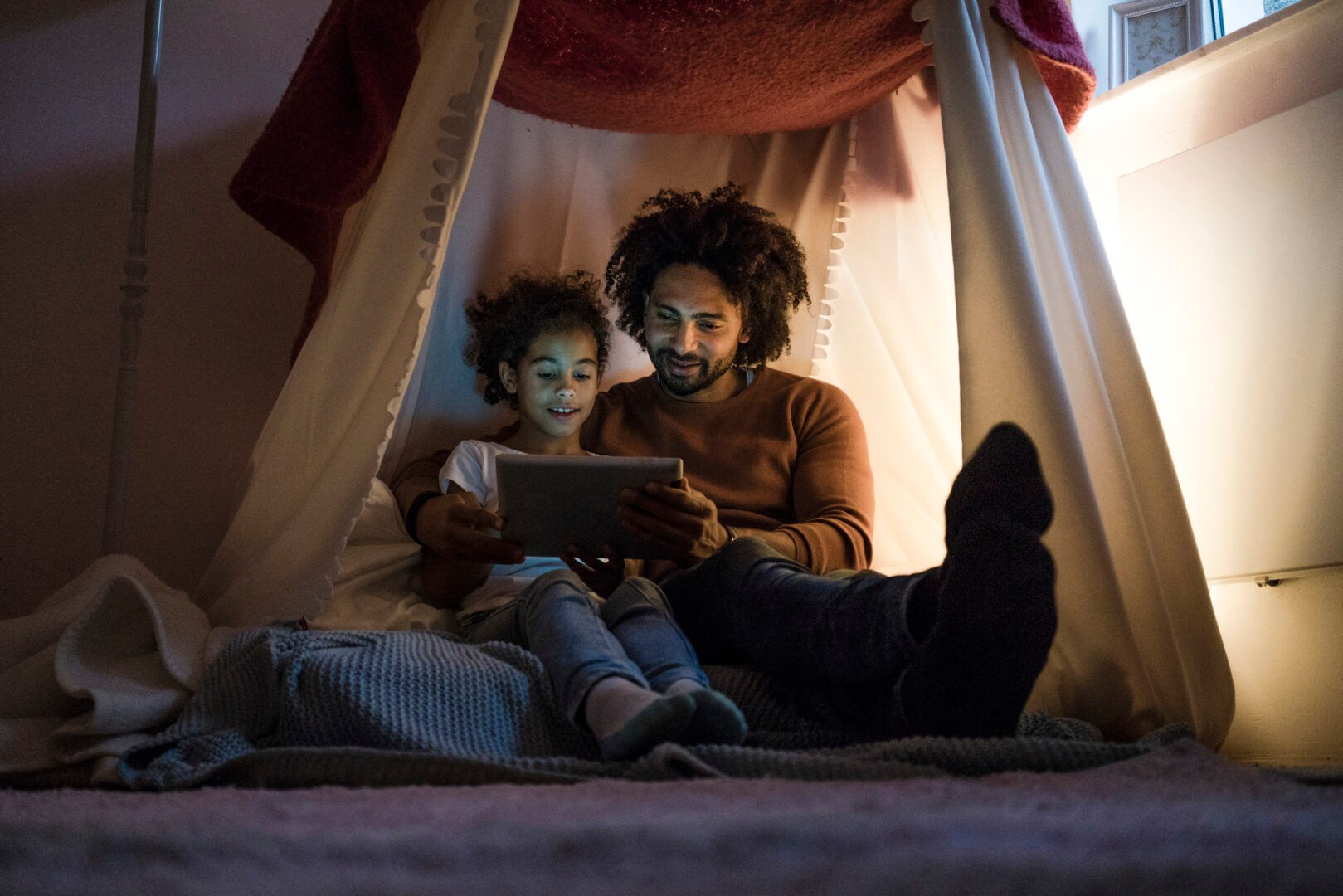Technology is supposed to make our lives easier, at least that’s what the talking heads in Silicon Valley keep telling us. But, as a 31-year-old mother of two who can barely use Snapchat, I keep wondering, how? Sure, I love that I can order food in a matter of minutes on my iPhone and instantly send snapshots of my kids to relatives who live thousands of miles away. But with all the various gadgets and devices on the market, it’s hard not to wonder if you’re actually getting the most out of your tech, especially as a parent.
The trick, I’ve found, is narrowing down what, exactly, works — and what is more of a gimmick. So, we asked parents to share the tech hacks they rely on every day, from genius safety shortcuts to tricks that turn getting out the door in the morning into a super hero adventure for young kids. (You’ll never have to keep yelling, “Let’s go!” again.)
Here are nine tech hacks real parents say they simply couldn’t live without.
1. Get a motion sensor for your kid’s bedroom door to monitor nighttime activity
For Nicole Skarke, a mom of one from Mckinney, Texas, putting a door sensor on her young son’s bedroom door is one of the best parenting hacks she’s ever tried.
Skarke uses a Z-Wave Plus door magnet that connects to her Samsung Smart Things Hub (similar to the Amazon Echo or Apple HomePod), but she says any door sensor will work as long as it’s compatible with your devices. When her young son opens his door, whether it’s to go potty or to sneak out of his room to play, she gets an alert on her phone.
Door sensors can also be added to the front door or to doors that lead to other unsafe places in the house. Not only does it ensure that Skarke’s son is never wandering around at night without her knowing, but she jokes, “It has been extra handy when we are in the media room upstairs and can quickly pause what we’re watching before he comes to find us.”
2. Streamline the morning routine with Out the Door
One of Amazon Alexa’s best hack for parents: Out the Door, which turns your morning routine into a “mission” for kids to complete. Each morning, kids are given a “super power” by Alexa (like being fast like a cheetah), then they have to battle a creature by completing different tasks, like brushing their teeth or packing their backpacks. They get points for each task and a certain number of points beats the creature. The points, powers and creatures change each day to keep it interesting.
“Mornings are always the toughest time for us,” says Cassie San Morello, a mom of two from Detroit, Michigan. “But I feel like this really does help. It gets them [the kids] excited about being up and getting ready, which is more than I can say for myself most mornings.”
To enable the function, search for Out the Door under “Skills” on the Alexa app.
3. Enable Guided Access on your iPhone to limit your kid’s access your email, texts and more
Letting kids play a game on your iPhone is an easy way to keep them occupied while they’re waiting to see a doctor or get seated at a restaurant, but giving a child a complex machine with the ability to send a text message full of poop emojis to your boss can be dangerous. To combat this, April Salazar, a mom of one from Brooklyn, New York, says parents with iPhones should know about Guided Access.
Guided Access puts temporary limits on the iPhone’s functionality. If turned on while you’re inside an app, the kids won’t be able to navigate outside of that app.
“I don’t have to worry about my daughter finding her way to my work email and sending inappropriate reply-alls,” says Salazar.
It also gives you options to set a time limit and disable the volume controls so kids can’t turn the sound up or down.
To turn on Guided Access, go to “Settings” on the iPhone and click “General.” Scroll down to “Accessibility” and click to enable “Guided Access” near the bottom of the list. After that, you’ll be able to quickly turn the function on and off by hitting the phone’s “home” button three times. The guided access screen will pop up, and “options” in the bottom left-hand corner is where you can enable and disable all of the different functions.
4. Buy a doorbell with a mute function for nap time
Most parents have been there: You’ve just spent 45 minutes putting the baby down for a nap, when out of nowhere, ding dong! It’s the UPS guy with that Amazon order you forgot about, and suddenly the baby is crying again.
That’s why Sarah Mitchell, a mom of two from Memphis, Tennessee, says buying a doorbell with a mute function is a total game-changer.
“You can mute it at naptime, bedtime — you can even keep it muted all the time if you also have pets who freak out [when a doorbell rings],” she says.
“Smart” doorbells by Nest, Ring, Honeywell and others all have the ability to be muted. When the chime is turned off, users simply get an alert on their phone if someone “rings” the bell. Check the instruction manual for your individual doorbell to learn how to activate this function.
5. Ask Alexa to tell the kids a story to keep them entertained
Games and shows are easy ways to distract kids when you need 10 minutes to make a phone call, but what about a story instead?
“[Amazon’s] Alexa will actually tell a story, with sound effects and everything,” says Alexis Johnson, a mom of three from Richardson, Texas. “It’s super helpful when my husband is out of town and I’m trying to get three kids to bed by myself.”
Alexa actually has a few different storytelling skills, such as Story Maker, which is kind of a modern choose-your-own-adventure book copycat, and Crazy Stories, which asks questions to create a silly story. To enable those or the regular Story Time skill, go to “Skills” on the Alexa app and search for “Story.”
6. Use timers to get kids to bed
When you have kids who refuse to stick to a schedule, timers on cell phones and tablets can mean the difference between getting them to bed on time or still having them up asking for snacks at 11 p.m.
“We use the timers on our phones all the time, but the biggest help has been at bedtime,” says Laura Winkler, a Washington mom of two. “After brushing teeth and story time, we settle down for a snuggle. My 5-year-old gets to set the timer, usually four to five minutes, and he feels in charge. When the timer goes off, it’s time for bed!”
Almost every device has a timer so it’s not hard to implement this hack, and Winkler says the simple trick has mostly eliminated the million excuses her kids will offer up to avoid going to sleep.
7. Use cell phone photos to keep track of important papers
It seems like the average school-aged kid receives approximately 1 million flyers and letters from school each week. While a physical filing system is great for important forms you need to keep on hand, the rest can be stored in a more succinct way: in a folder on your cell phone after you take a photo of them.
“I use my cellphone to take photos of my kid’s sports schedule, volunteer schedule, calendars, etc.,” says Jeanne Sager, a mom of one from Upstate New York. “That way I don’t have to worry about losing the piece of paper. It’s always on my phone.”
8. Turn off autoplay on Netflix to limit binge-watching
Adults aren’t the only ones who binge on Netflix shows. If left as-is, the streaming service will automatically play episode after episode of kids’ favorite shows. But there’s a way to stop it — and limit temptation for watching “just one more,” says Elizabeth Long, a mom of one from Wheat Ridge, Colorado.
“You can turn off autoplay,” she says.
To do this on the Netflix app, go to “Account” and scroll down to “Playback Settings” and uncheck the box where it says “Play next episode automatically.” Then hit Save. You can have different settings for different profiles, too.
“That way when you tell them they can only watch one episode, that’s actually what happens,” Long says.
9. Use your phone as a teaching tool
Megan Zander, a mom of two from Danbury, Connecticut, doesn’t solely rely on educational apps to help her kindergarteners learn new things. Instead, she lets her phone do the teaching.
“I’m a fan of using Notes on my iPhone to let the kids practice typing words while in line at stores,” she says. “And texting ‘Hi Grandma!’ is good keyboard memory practice.”
Zander isn’t the only one who uses her phone as an educational tool. Ysis Lorena, a mom of four and YouTube personality who lives in Wales, says she actually records videos of herself teaching her kids letters, numbers and sounds, and lets them watch those instead of cartoons.






